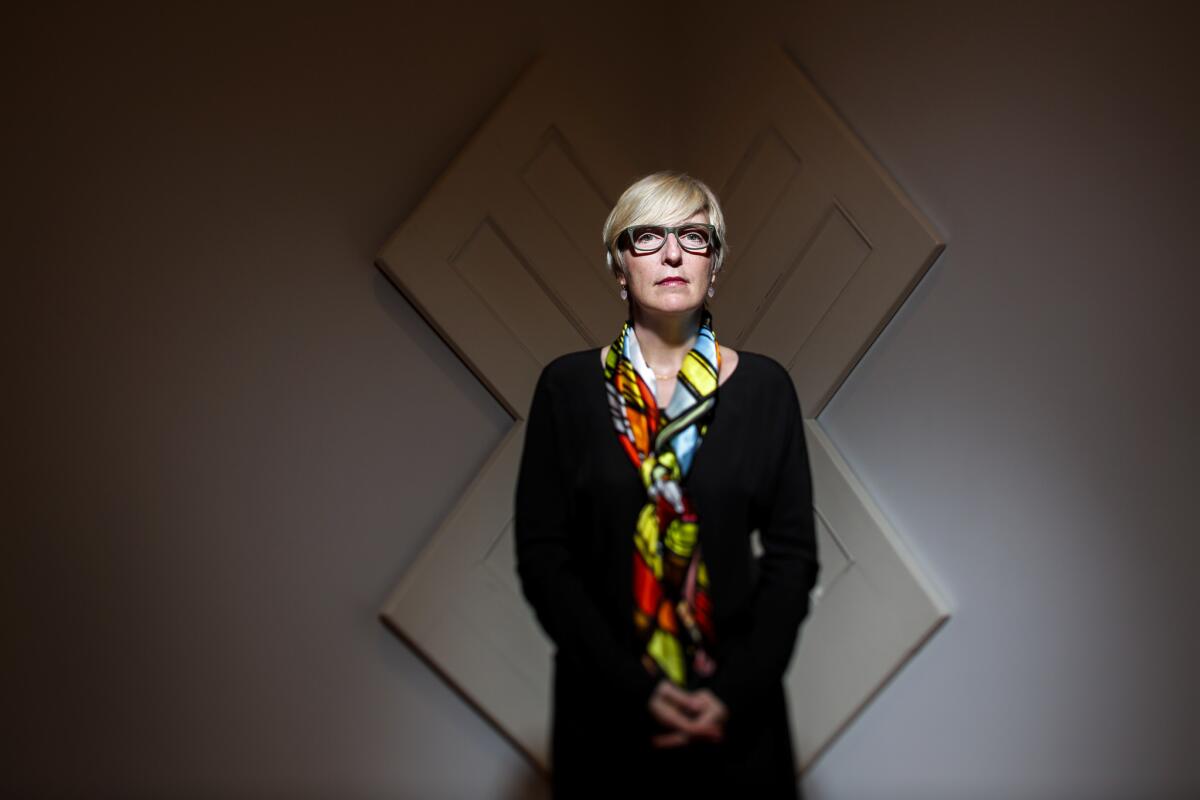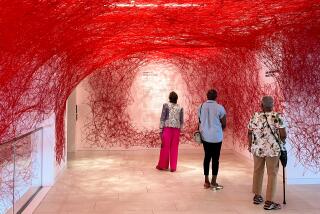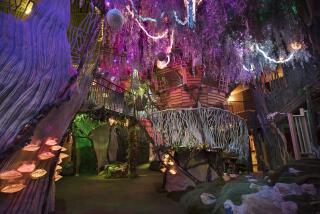Helen Molesworth, MOCA’s new chief curator, relishes the possibilities

On this dark, rainy afternoon, Museum of Contemporary Art chief curator Helen Molesworth is hunkered down inside her office, bundled up in the copious folds of a fuzzy, gray sweater — and she is making sausage.
That’s what Molesworth calls this sneak peek into her curating process as she prepares her take on the museum’s permanent collection, an exhibition set to open next fall. “So you wanna see how it’s done, eh?” she says, swinging open a door across the hall. “How we make the sausage?”
The bare space, not much larger than a walk-in closet, houses a cardboard model of the museum’s galleries. Minuscule replicas of artworks in MOCA’s collection are scattered across a tabletop, arranged in messy alphabetical piles — a Chiclet-sized Jackson Pollock painting, a Monopoly game piece-like Rachel Harrison sculpture, a collection of itty-bitty black-and-white photographs by Christopher Williams — all spread out as if a puzzle-in-progress on a stormy Sunday.
Molesworth hovers over the roofless model, a dollhouse re-creation of MOCA’s south galleries, complete with entryways and interior walls dotted with sticky tape — a blank canvas on which the curator experiments. She reaches into the faux museum and maneuvers the teeny maquettes.
“See, everyone thinks Frank Stella is really different from Mark Rothko. But maybe …”
Her voice trails off pensively while affixing the artists’ works, side by side.
“Maybe, thinking about color, Rothko leads us to Stella.” She tilts her head, considering the juxtaposition; with her short, blond mod cut and chunky silver jewelry, Molesworth appears part stylish New York art scholar and part schoolgirl tinkering with miniatures. “I block off whole days to spend in here and just play with the model. It’s how the ideas marinate.”
‘Total blank slate’
As a self-described feminist art historian, context is of the utmost importance to Molesworth, 48, who took her post in September after serving as chief curator at the Institute of Contemporary Art/Boston for 41/2 years. Her appointment is a significant step in MOCA’s emergence from financial and organizational crisis after the departure of former museum director Jeffrey Deitch in 2013. That shaky history, however, and the possibility of what lies ahead, are partly what drew Molesworth to the job in the first place. She sees MOCA at a rare juncture.
“On the one hand, you have this great, rigorous collection, one of the best exhibition histories in the country,” she says. “On the other hand, it’s a total blank slate. We’re rebuilding, and you can make it all up.”
With no major exhibitions since a Mike Kelley show in March, MOCA recently announced its 2015-16 exhibition schedule. It includes an Elaine Sturtevant retrospective, coming from New York’s Museum of Modern Art this spring, and a Matthew Barney exhibition, his first major museum show in L.A., co-organized by Germany’s Haus der Kunst and the Museum of Old and New Art in Australia, opening here next fall.
Museum exhibitions typically take three to five years to develop, so it’s no surprise that the lineup — which new MOCA director Philippe Vergne and Molesworth expedited by working with artists the two had relationships with — includes “already cooked” exhibitions coming from other institutions. But the schedule also has an original show with new work by Chicago-based William Pope.L as well as Molesworth’s opening gesture to Los Angeles: a deeply considered, curated take on MOCA’s permanent collection.
“It’ll be chronological in sweep, and you can have that great museum experience where you just walk through time,” she says of the show, which will open at MOCA Grand Avenue around the time the Broad museum opens across the street — something Molesworth hopes will spark a dialogue between the museums.
Another reason for the reinstallation show: “There’s all this good will and energy around MOCA right now,” Molesworth says, “and I’d like to sort of repay that with an amazing exhibition that says, This is why this was an institution worth saving.”
Given art history’s “dude-heavy” bent, she says, the reinstallation is also an opportunity for Molesworth “to enter women into the canon or reinsert women who should have been in the canon to begin with.” She’s looking forward to showcasing MOCA works by Ree Morton and Cady Noland, but it’s not as simple as cobbling together an exhibition consisting of 51% female artists, she says. “My feminism is slightly more expansive than that; it’s also about thinking about the men differently, debunking ideas that attend male superiority.” Molesworth cracks a knowing smile. “Though I am known for putting a lot of women in the room.”
Vergne has said that bringing more women, emerging artists and artists of color into MOCA is central to his vision. Molesworth’s “rigorous and inclusive” sensibility, he says, is key to making that happen.
“We both feel that the diversity of the world around us should be reflected in every room of the museum,” Vergne says. “She knows that museums are built on relationships with artists, patrons and audiences and has a talent to bring people together around complex ideas.”
Toward that end, the exhibition schedule also includes a fall 2016 retrospective of work by female New York artist R.H. Quaytman; her paintings blend elements of geometric abstraction, photography and literary history. A spring 2015 exhibition features L.A.-based artist Kahlil Joseph, whose art film, “m.A.A.d,” traverses largely African American neighborhoods in L.A. and has a soundtrack by hip-hop artist Kendrick Lamar.
“That’s where I think the task of the museum lies in the 21st century — making this history alive and relevant while tethering the art of our time to the ground it comes out of,” Molesworth says.
Museums as touchstones
Art museums have always grounded Molesworth, who considers the New York borough of Queens home, though she grew up around the world with parents prone to wanderlust — a quality she says she inherited. Her father, who taught American poetry at Queens College, arranged for a sabbatical as well as teacher exchanges whenever he could. Molesworth moved frequently among England, Finland and France from first through ninth grades.
Museums provided a window into whatever new culture Molesworth was settling into as a kid. They were how she got her bearings. Artworks became friends for a lonely kid who often felt “geeky and displaced.”
“Even now, my idea about travel is: You go to another place and visit their museums,” she says. “That’s where you begin. It’s a window into how people think and feel.”
Molesworth appears to tear up retelling the story of encountering her first Rauschenberg combine at the Moderna Museet in Stockholm when she was 10. “It was a crazy one, the goat with a tire around its middle,” she says of the artist’s blending of painting and sculpture. “Maybe it has something to do with being a feminist or queer. Because that’s a really queer object, in the old sense of the word. I liked how weird it was. I think I related.”
The recent move to L.A. has been joyfully jarring, says Molesworth, married to Susan Dackerman, the curator of prints for the Harvard Art Museums. Before her stint at ICA/Boston, Molesworth was a curator of contemporary art at the Harvard Art Museums, so she lived in that city for eight years. Boston, demographically, felt “like a bubble” to Molesworth. The diversity of L.A. “feels like the world writ large, hanging out in the sunlight, nowhere to hide.”
Molesworth, who now lives in the Mid-Wilshire area, has found herself having different kinds of conversations with artists in L.A. than she typically has in London and New York. She attributes this to the natural geography and space of L.A., which affords for more live-work studios.
“There’s a kind of intimacy to living and working in the same space,” she says. “I’ve noticed an interest in domestic life, domestic space, dailyness, that I think informs a lot of the work I’ve seen here and many of my conversations with artists.”
Then there are carnitas. A proud foodie, Molesworth is smitten with Sunday suppers at Lucques in West Hollywood, Canelé in Atwater Village and Grand Central Market downtown. She’s on a tear, she says, “working my way through all the carnitas in L.A.”
At work, she still spends part of every day flipping through stuffed binders documenting the museum’s collection — “and what’s not there,” she says. “Reinstalling the permanent collection is a great way to figure out what you need.”
On her wish list for the museum: “A Romare Bearden, a Mark Bradford — that’s something that needs to be redressed — work by Sharon Hayes, Amy Sillman and Pierre Huyghe.” Molesworth, who succeeds former chief curator Paul Schimmel, is also aiming to fill holes in MOCA’s staff, taking its three curators, including her, to 5, with the first hire hopefully in early 2015, she says.
L.A. painter Lari Pittman — featured in Molesworth’s 2012 ICA/Boston show “This Will Have Been: Art, Love & Politics in the 1980s,” a re-examination of ‘80s culture and contemporary art looking at feminism, AIDS, capitalism and queer culture — calls Molesworth “an artists-identified curator” whose strong ties within the art world will aid MOCA in its rebuilding efforts.
“MOCA needs to fix its relationship with the artists community, which was tremendously damaged in the last few intervening years — Helen can do that,” Pittman says. “She’s interested in getting into artists’ studios and having conversations with them and doing that kind of traditional, historical field work, which is rare. She’s accessible — and really funny.”
Molesworth is particularly excited about the upcoming retrospective of African American artist Kerry James Marshall, an exhibition she curated for the Museum of Contemporary Art in Chicago before taking the L.A. job. It opens here in spring 2017.
“He grew up in Watts and studied in L.A. He’s formed by Los Angeles in really powerful ways,” she says. “I think that hasn’t yet been brought out because he’s more identified with Chicago, so I’m excited to bring it here.”
Molesworth is also planning an exhibition of large-scale installations from MOCA’s permanent collection — some of which take up an entire room for one artist’s work — for the museum’s Geffen Contemporary in early to mid-2016.
“The curator does the work to have them acquired, but then you don’t see them again because they’re big and complicated to install and they’re space hogs,” she says. “But MOCA is not hamstrung by space constraints; the Geffen is a space of enormous permission. You can tell a big story there.”
As the rain pitter-patters against the windows, Molesworth flips a tiny representation of a Liz Larner wire sculpture between two fingers. It will take months of working with the model to fully shape the reinstallation. Then there is “military logistical planning,” as Molesworth puts it, involving conservation and framing, light level restrictions, installation equipment and other challenges that can throw off the whole puzzle.
She affixes a miniature Pollock painting to a tiny, blank wall.
“There. Maybe that’s the beginning,” she says. “See, we’re only just starting. I’m actually not even making sausage yet — I’m just assembling the meat.”
Twitter: @debvankin
More to Read
The biggest entertainment stories
Get our big stories about Hollywood, film, television, music, arts, culture and more right in your inbox as soon as they publish.
You may occasionally receive promotional content from the Los Angeles Times.











